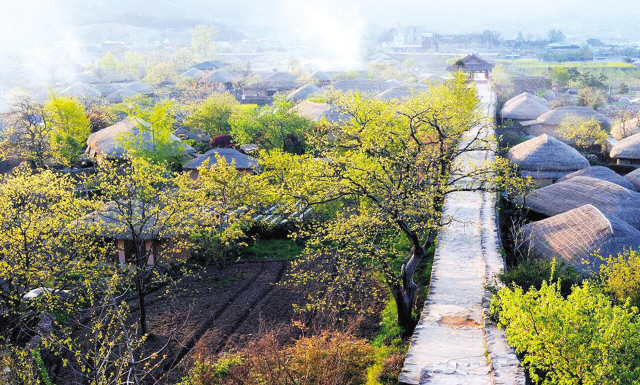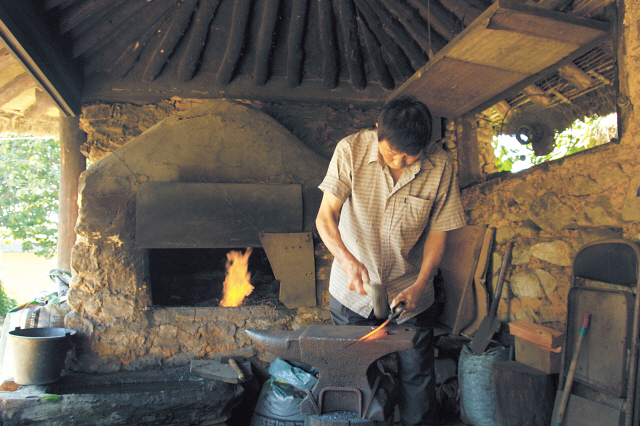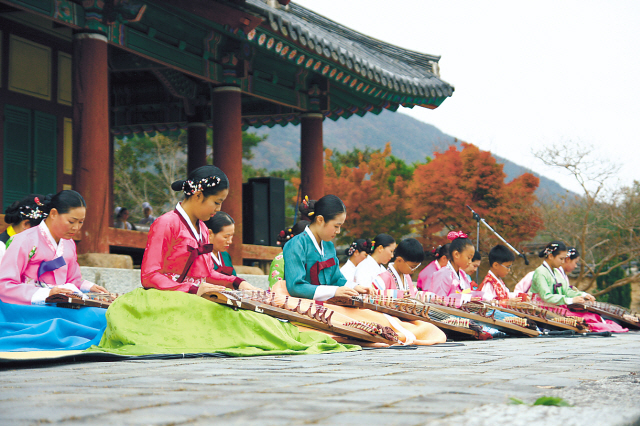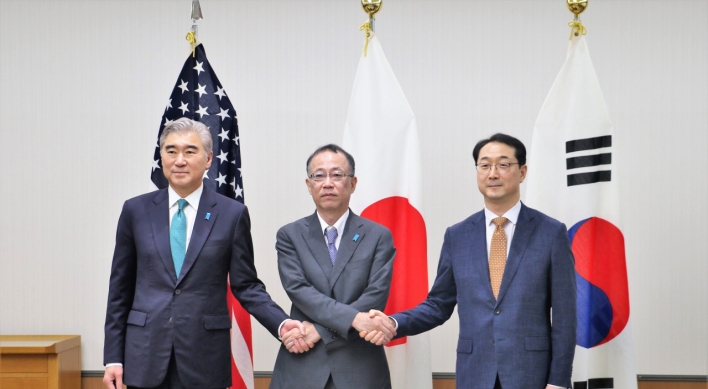Traditional village with 600 years of history
Nagan Fortress boasts rich culture and natural resources
By Claire LeePublished : March 6, 2013 - 20:57

The Korea Herald is publishing “Korea’s Cultural Pride,” a 10-part series on the country’s cultural and natural heritage. A total of nine tangible and 14 intangible examples of heritage in Korea have already been designated UNESCO World Heritage items for international preservation. This year,15 cultural properties are on the tentative list, awaiting designation. This installment explores the Naganeupseong, Town Fortress and Village, in Suncheon, South Jeolla Province, which boast 600 years of history with well-preserved natural and cultural resources. ― Ed.
Located in Suncheon, Naganeupseong, or Nagan Fortress, is the only remaining Joseon period (1392-1897) fortress in South Jeolla Province. With about 100 traditional houses and government offices, the Nagan village survived time and modernization. Stepping into its village, one could feel as if they’ve gone back to the past to the Joseon era.
The fortress, measuring 1,410 meters in length, was first built in 1397 during King Taejo’s reign, by Joseon general Kim Bin-gil after the defeat of Japanese pirates to protect the area. The general used sand to build the wall, but the property was changed to a stone wall in 1626 during King Injo’s reign.
The fortress and the village boast some 600 years of history, with well-preserved natural resources including some 30 ancient trees. There are still about a hundred residents living in the traditional folk village, many of whom are farmers, carrying on the traditional values and arts of the region.
“The famous traditional villages such as Yangdong Folk Village in Gyeongju and the Hahoe Folk Village in Andong are clan-based villages where the country’s aristocrats lived,” said Seo Ju-won from the city of Suncheon. “But the village in Nagan was occupied by the commoners. That’s the major difference.”
The stone wall was built under the guidance of Joseon’s prominent general Im Gyeong-eop (1594-1646), who participated in Korea’s war against the Manchurian invasions of the 17th century. He served as the governor of Nagan from 1626 to 1628, and built the stone wall to strengthen the security of the town.
Before starting to build the stone wall, the general is said to have gotten into a competition with his older sister. He and his laborers would build the property, while the general’s sister would grow cotton and make military uniforms for some 2,000 soldiers. Whoever finished their task first would win.
It was, in fact, his sister who completed her mission first, but thinking her win could discourage the laborers, she purposely cut one of the jacket ties and secretly waited until the completion of the wall. Thinking they still had the chance to win, the laborers worked hard to accomplish their mission. Im’s sister patched up the jacket tie after the wall project was finally completed, letting her brother’s team win. Her story is still told in the Suncheon region as a great example of a considerate and generous mind.
Located in Suncheon, Naganeupseong, or Nagan Fortress, is the only remaining Joseon period (1392-1897) fortress in South Jeolla Province. With about 100 traditional houses and government offices, the Nagan village survived time and modernization. Stepping into its village, one could feel as if they’ve gone back to the past to the Joseon era.
The fortress, measuring 1,410 meters in length, was first built in 1397 during King Taejo’s reign, by Joseon general Kim Bin-gil after the defeat of Japanese pirates to protect the area. The general used sand to build the wall, but the property was changed to a stone wall in 1626 during King Injo’s reign.
The fortress and the village boast some 600 years of history, with well-preserved natural resources including some 30 ancient trees. There are still about a hundred residents living in the traditional folk village, many of whom are farmers, carrying on the traditional values and arts of the region.
“The famous traditional villages such as Yangdong Folk Village in Gyeongju and the Hahoe Folk Village in Andong are clan-based villages where the country’s aristocrats lived,” said Seo Ju-won from the city of Suncheon. “But the village in Nagan was occupied by the commoners. That’s the major difference.”
The stone wall was built under the guidance of Joseon’s prominent general Im Gyeong-eop (1594-1646), who participated in Korea’s war against the Manchurian invasions of the 17th century. He served as the governor of Nagan from 1626 to 1628, and built the stone wall to strengthen the security of the town.
Before starting to build the stone wall, the general is said to have gotten into a competition with his older sister. He and his laborers would build the property, while the general’s sister would grow cotton and make military uniforms for some 2,000 soldiers. Whoever finished their task first would win.
It was, in fact, his sister who completed her mission first, but thinking her win could discourage the laborers, she purposely cut one of the jacket ties and secretly waited until the completion of the wall. Thinking they still had the chance to win, the laborers worked hard to accomplish their mission. Im’s sister patched up the jacket tie after the wall project was finally completed, letting her brother’s team win. Her story is still told in the Suncheon region as a great example of a considerate and generous mind.

When Im finished his term as governor in 1628, the people of Nagan are said to have gathered at his house and sobbed, and followed him for about 3 kilometers as he was leaving the region for good. A monumental house commemorating Im’s life, which was built by the people of Nagan after his death in 1646, remains in the village today. A number of cultural events are held every year on Daeboreum, a traditional holiday that celebrates the first full moon of the year of the lunar calendar. Visitors can enjoy the country’s traditional rituals and games, including seesaw jumping and swings.
The Nagan has nine thatched-roof houses that were built in 19th-century Joseon, according Seo. The houses are designated as national heritage and managed by the central government.
“These houses are valuable examples of 19th-century architecture of the South Jeolla region,” said Seo. “These are the houses where the commoners raised their families.”
The Korea Tourism Organization says the houses and their clay rooms and Korean-style verandas show the “dwellings indigenous to the south provincial area.”
Aside from the residential buildings, the village still houses family shrines, pavilions, and study halls from the Joseon era.

The village is also famous for its traditional music scene. Renowned pansori artist Oh Tae-seok, who is known for his use of gayageum, a Korean traditional 12-stringed zither, when performing pansori, a narrative song accompanied by percussion instrument, was born in the village. His music enjoyed much popularity in the 1930s, when Korea was under Japanese colonial rule. One can visit the thatched-roof house where Oh was born, which has been well preserved by the city of Suncheon.
The village is a venue for many other genres of Korean traditional music, including “nongak,” farmer’s music, communal rituals, and pansori epic chant.
The fortress and the village are home to a lot of traditional, cultural events of the region. One of the most celebrated events held at the village is the annual South Jeolla Food Festival, where they can enjoy and learn how to make the famous regional cuisine. The festival is thrown every year in October.
Naganeupseong Town Fortress and Village were included on the tentative list of UNESCO’s World Heritage Sites in 2010. The selection of new sites will be announced in June.
By Claire Lee (dyc@heraldcorp.com)










![[New faces of Assembly] Architect behind ‘audacious initiative’ believes in denuclearized North Korea](http://res.heraldm.com/phpwas/restmb_idxmake.php?idx=644&simg=/content/image/2024/05/01/20240501050627_0.jpg&u=20240501225745)







